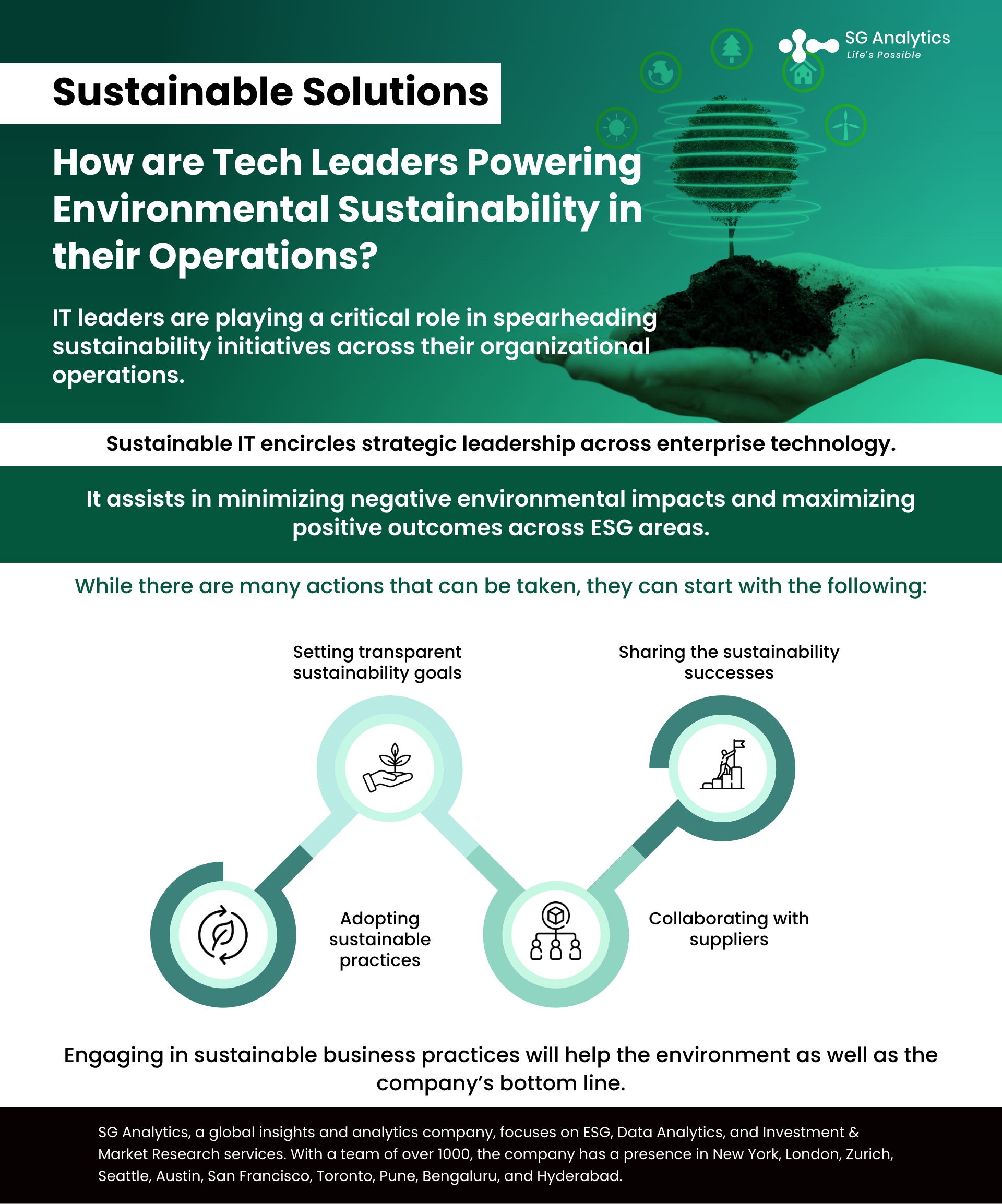Today, IT leaders are playing a critical role in spearheading sustainability initiatives across their organizational operations. The emergence of the Internet of Things (IoT) and generative AI are putting increasing pressure on data centers across the globe. And Enterprise IT is contributing significantly to the global carbon footprint.
With the number of devices expected to reach 55.7 billion by the year 2025, it has become more critical than ever to understand the environmental consequences caused by big tech. This grey area highlights why enterprises are continuing to fall behind in lesser-discussed sustainability drivers such as data.
The Underlying Data Addiction
Many leaders consider their organizations sustainable as they prioritize ecologically conscious initiatives. While admirable, these initiatives just scratch the surface of sustainability, especially for data-intensive enterprises.
In today's digital world, which is expected to generate more than 180 million zettabytes annually by the year 2025, it is safe to say that the world indeed has a data addiction. However, data is not the problem. How we collect, store, and interact with data is.
With the Internet of Things (IoT) reaching new heights, data’s carbon footprint is becoming more prominent, further illuminating the unsustainable nature of data storage practices. These data storage practices are non-sustainable. And matters are only likely to worsen as the volume of data is set to skyrocket.
Read more: What is Carbon Footprint: How to Reduce and Calculate Carbon Footprint?

However, most enterprises have more data than they can handle. This over-reliance on data storage has led organizations to store sensitive information. However, there are better and more sustainable ways to store this information. Leaders can work towards creating a records retention schedule that helps systematically save and dispose of data.
Data in motion can effectively communicate with interconnected systems and offer organizations actionable insights for applications and software. However, leaders need to strategize on protecting data in motion without overtaxing their systems. They can accomplish this task by integrating intelligent automation tools to decipher massive amounts of data. They can use AI and machine learning (ML) to catalog contextual error data. AI can also be used for IT operations to identify valuable versus expired data and streamline anomalies.
A Sustainable IT report issued by Capgemini highlighted that 89% of companies surveyed recycle less than 10% of their IT hardware. With environmental impact emerging as a critical area of concern, IT leaders are taking responsibility and developing strategies to influence meaningful change.
ESG adherence is good for business in more ways than one. Organizations can minimize their environmental impact and maximize their financial gains as sustainable enterprises. By being the agents of change, modern businesses can exercise their social responsibility for good and improve their practices related to people and the environment.
In the last decade, environmental, social, and governance (ESG) investments have spiked, and Gartner forecasted that 60% of public companies will regularly disclose non-financial sustainability information by the year 2026.
Despite the rapid growth in ESG, critical parameters about sustainability are yet to emerge. While many businesses face environmental output regulations, others benefit from green tax incentives. But what distinguishes a sustainable product from a non-sustainable one?
Read more: Building Data Trust: How Leaders are Nurturing and Measuring Stakeholder Trust for Growth

Understanding Sustainable IT Solutions
Sustainable IT encircles strategic leadership across enterprise technology. It assists in minimizing negative environmental impacts and maximizing positive outcomes across ESG areas.
Let’s explore the three pillars of ESG in the context of sustainable IT
-
Environment: This area of sustainable IT focuses on green infrastructure, implementing circular technology strategies, and incorporating measures to achieve carbon neutrality. Organizations can transition to renewable energy and implement sustainable technology sourcing to reduce waste.
-
Social: This component concentrates on addressing technology accessibility as well as the innovation of technology systems that benefit society. Organizations can evaluate the safety impacts of their services and drive diversity within their ecosystem.
-
Governance: This aspect focuses on data usage, privacy, and responsible technology. Companies should be transparent about their strategies and risk management, as well as work towards upskilling and reskilling their employees with a focus on establishing a sustainable talent pipeline.
Embracing Responsibility for Growth
There is no one-size-fits-all approach when it comes to incorporating sustainability into industry operations. Technology leaders need to be the ones to step up and implement the company’s sustainability plan. By becoming agents of change, they can make sustainability solutions a larger initiative within their organization and encourage employees across all levels to get involved to work toward this unified goal.
Read more: Climate Change and the USA: What to Expect in the Future?

Engaging in sustainable business practices will help the environment as well as the company’s bottom line. It is, therefore, critical for technology leaders to break free of the mindset, drill down on their priorities, and set themselves up for success on a more sustainable path.
While there are many actions that can be taken, they can start with the following:
-
Setting transparent sustainability goals
By creating specific, measurable, and attainable standards toward sustainability, organizations can make their goals relevant and in accordance with larger standards. This will help ensure that leadership is continuously integrating frameworks to keep the company on the path toward achieving its goals.
-
Adopting sustainable practices
By transitioning from an on-premises infrastructure to cloud computing, organizations can gain significant energy savings. Cloud hosting also assists with remote work, thus eliminating the need for using additional energy or resources.
-
Collaborating with suppliers
Staying in constant communication with suppliers and engaging them in eco-friendly operations will help in achieving the greater goal of incorporating sustainable practices and environmentally friendly materials.
-
Sharing the sustainability successes
As an IT leader, it is vital to have a voice and a platform to advocate for change. It is important to share successes, challenges, as well as future sustainability plans to encourage others to venture on this path.
Read more: Data-driven Sustainability Initiatives: Harnessing the Power of Data to Drive Change

Tech Leaders: The Agents of Change
Industry leaders play a vital role in spearheading sustainability initiatives within their organizations. However, implementation challenges can present a few roadblocks. A lack of standards to evaluate the organization's carbon footprint also presents challenges. This is where leadership needs to step up their operation. They need to cultivate the right relationships and best position the framework to champion this change.
-
They can foster a more environmentally friendly business environment by asking the right questions, initiating changes, and implementing strategies.
-
They can improve employee sustainability awareness and streamline data processes in order to optimize efficiency and reduce electric consumption.
-
By streamlining workflows, optimizing their organizational efficiency, and leveraging automation to save time, energy, and cost - all efforts will contribute towards achieving the sustainability goals.
-
By empowering the workforce and ensuring employees are well-equipped with the essential skills, tech leaders can further drive this transition to create a sustainable future.
Additionally, industry leaders should also consider embracing greener data storage practices, such as digital minimalism, that will help in incorporating a more thoughtful approach toward data hygiene. It is time for leaders to take these initial steps and break their organization’s data addiction. By doing so, they can improve their adherence to ESG principles and improve operational efficiency.
SG Analytics, recognized by the Financial Times as one of APAC's fastest-growing firms, is a prominent insights and analytics company specializing in data-centric research and contextual analytics. Operating globally across the US, UK, Poland, Switzerland, and India, we expertly guide data from inception to transform it into invaluable insights using our knowledge-driven ecosystem, results-focused solutions, and advanced technology platform. Our distinguished clientele, including Fortune 500 giants, attests to our mastery of harnessing data with purpose, merging content and context to overcome business challenges. With our Brand Promise of "Life's Possible," we consistently deliver enduring value, ensuring the utmost client delight.
As a leading ESG services firm in the US, SG Analytics’ ESG data analytics and research solutions are driven by secondary research to analyze ESG trends, metrics, news, and controversies. Contact us today if you are in search of generating deep insights and incorporating ESG (Environmental, Social, and Governance) integration and management solutions to boost your sustainable performance.









